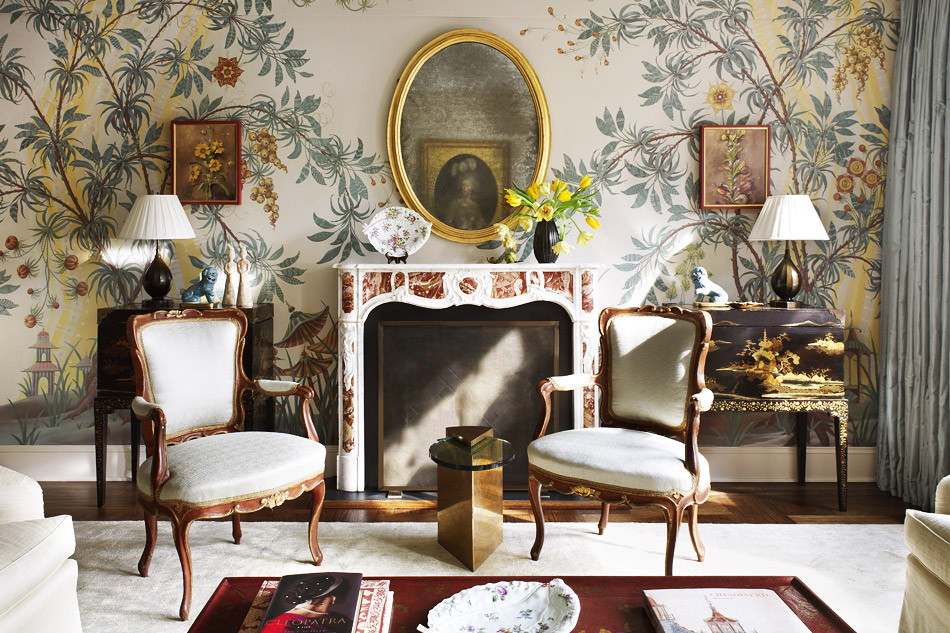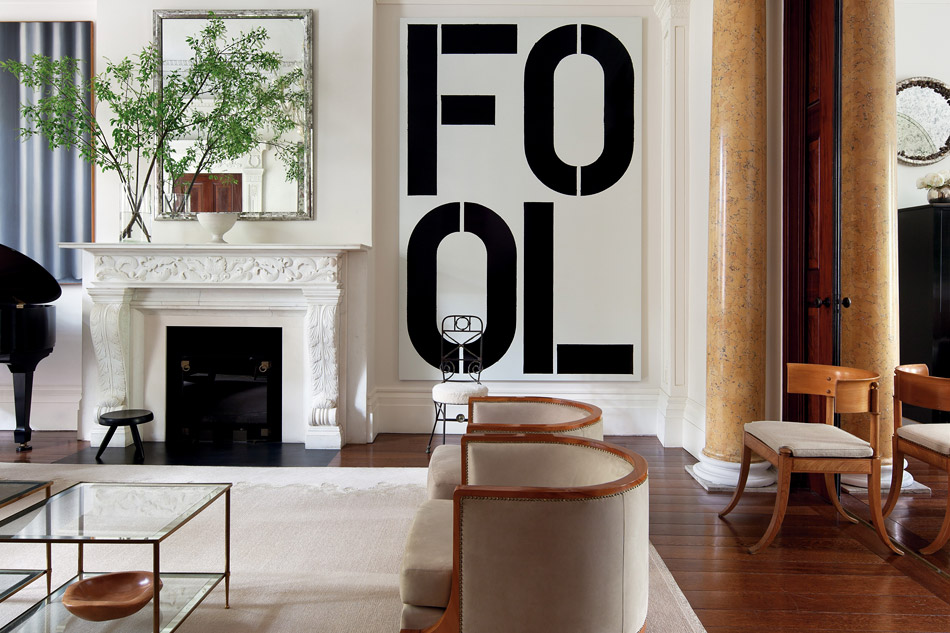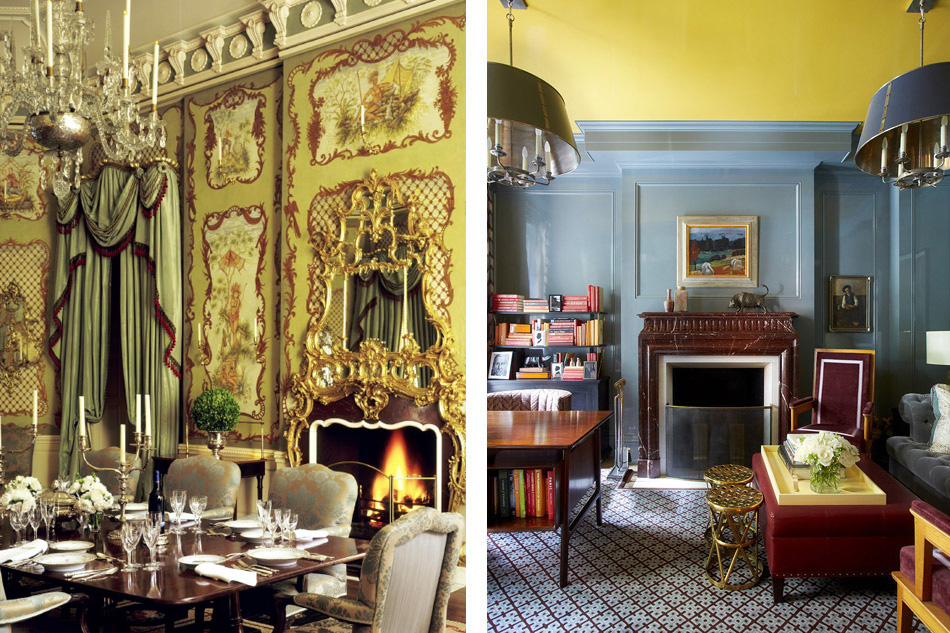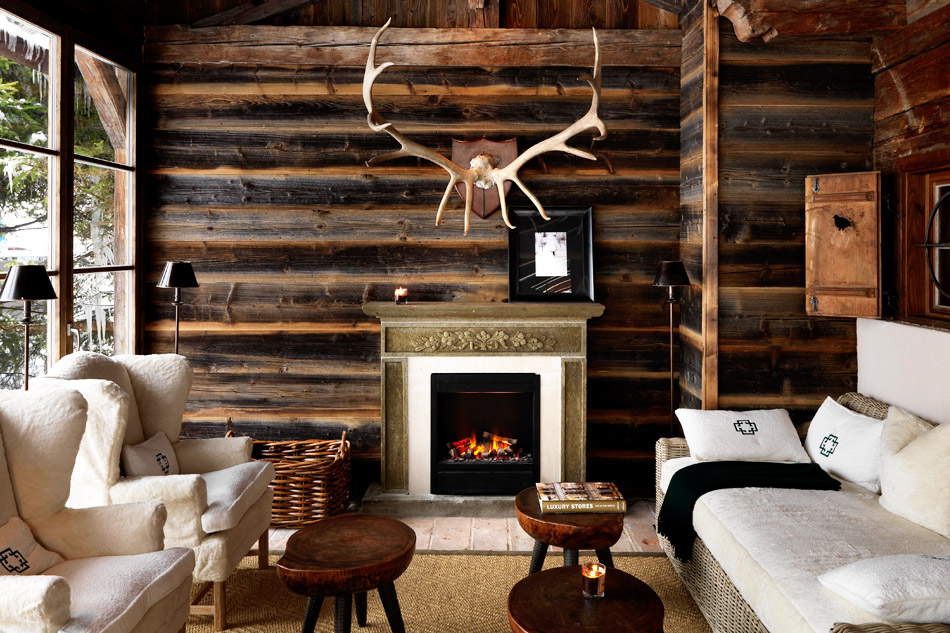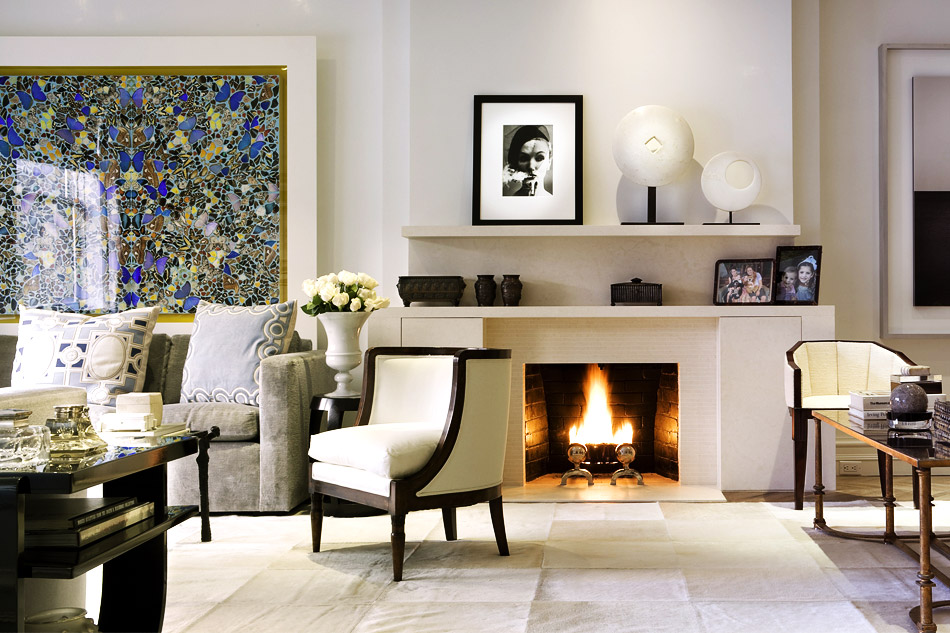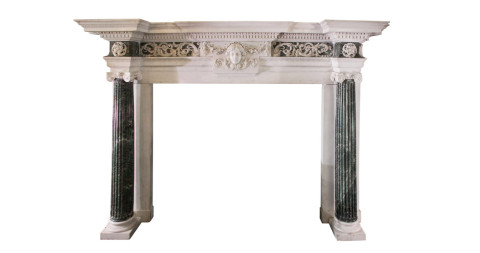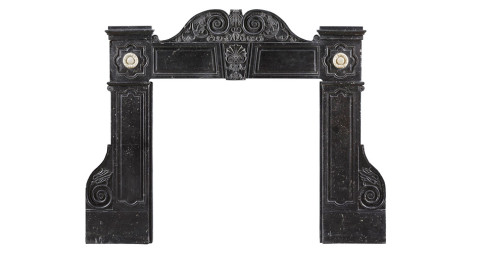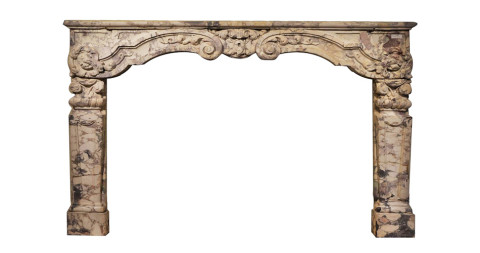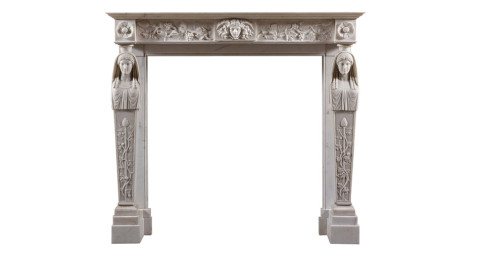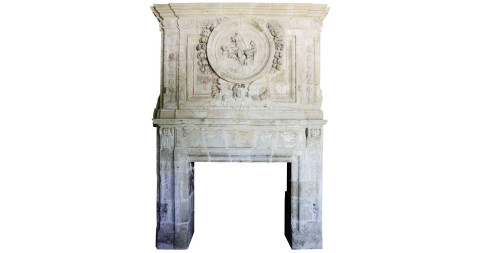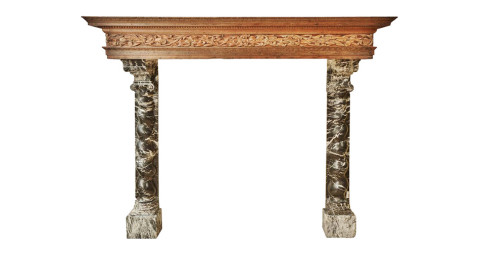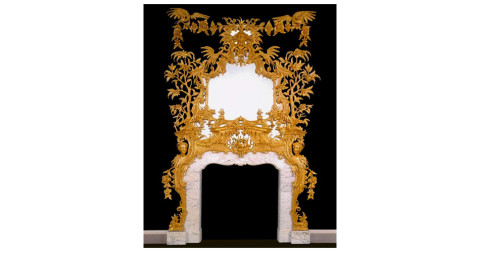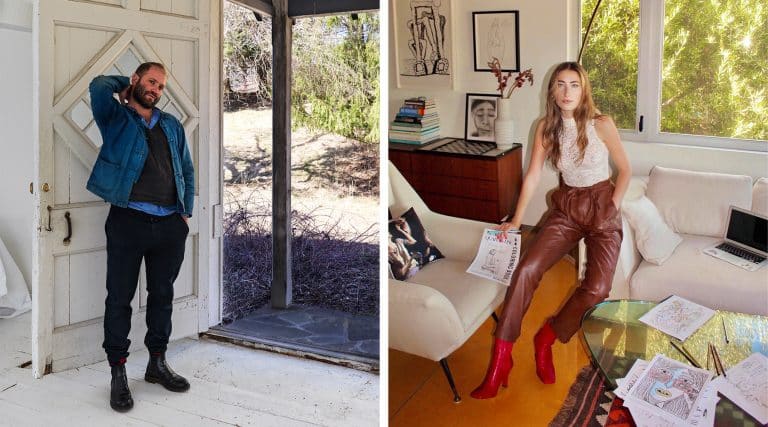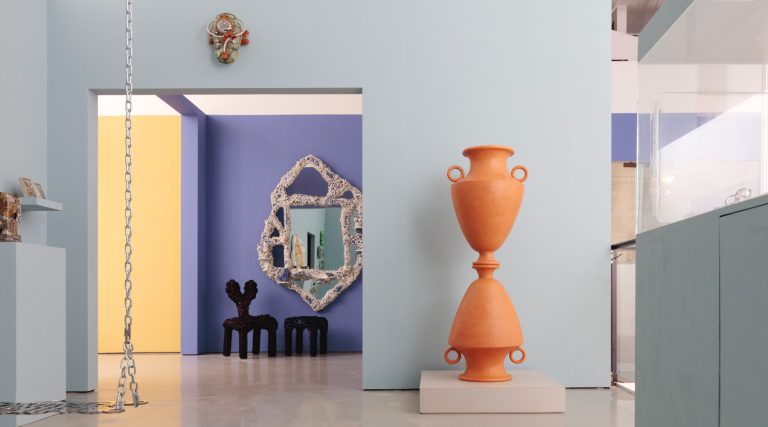
November 23, 2015Manhattan designer Tony Ingrao recently installed this 16th-century French limestone example from Origines for clients (photo courtesy of Tony Ingrao). Top: Markham Roberts flanked a modern neoclassical mantel with a Biedermeier scroll chair and a 1970s Arne Norell chair (photo by Nelson Hancock, courtesy of Markham Roberts).
Whether it’s a Louis XIV fireplace from a Loire Valley château, a Dutch mantelpiece made of violet breche marble from a quarry exhausted centuries ago or a gleaming white mantelpiece with a Bacchanalian frieze designed by pioneering neoclassical architect James Stuart for an 18th-century London townhouse, few decorative objects have backstories as colorful as those of antique fireplaces. And few things can rival them when it comes to adding ambience to a room, especially when they hold a crackling fire that makes staying cozily indoors at this season, surrounded by family and friends, all the more festive.
“With antique fireplaces, you get heart, soul, character and architecture,” says Tony Ingrao, a Manhattan-based interior designer who recently purchased an important 16th-century French limestone fireplace from Origines for a client’s Greenwich Village townhouse. “We blew out the whole parlor level, and as soon as you enter, the fireplace is what you see. It’s the focal point.”
Whether in marble or limestone, a surprising number of ornate 17th- and 18th-century mantelpieces (or chimneypieces, as they’re often called in Europe) are finding their way into today’s residences as homeowners remodel or build anew. Prices range from the low five figures to more than half a million for a piece with a storied provenance, like the circa-1750 marble chimneypiece — a confection of verde antico marble and white statuary designed by Isaac Ware for the fourth Earl of Chesterfield’s London townhouse — that is offered by Chesney’s on 1stdibs.

Tom Jackson, of Jamb, Ltd., in London, notes that in Britain one often finds fireplaces that were carved in Italy for the English market. Jamb, however, is currently selling Chesham, above, an early George III–style mantel carved from local Bath stone. Photo courtesy of Jamb, Ltd.
Even more over the top is a profusely carved and mirrored George III–period giltwood chimneypiece attributed to Matthias Lock, a drawing of which is in London’s Victoria and Albert Museum. It’s dearer, too. Ronald Phillips, Ltd., a London-based dealer, is asking $1,200,000.
“These pieces change hands more frequently than you might think, as apartments are purchased by people with different tastes,” says Katherine Perino, a business-development manager at Chesney’s, which has been in the antique-fireplace trade since a young Paul Chesney, unhappy with his chosen profession of law, went dumpster diving in London 30 years ago.
Many of the antique fireplaces on the market today were removed from their original settings long ago, as new heating methods made them functionally obsolete, rural castles and manor houses were abandoned and fell into ruin, and widespread road construction led to the demolition of houses throughout Europe. In the past couple of decades, with new protections in place for historic properties, getting permission to remove a 300-year-old objet d’art has become increasingly difficult.
Samuel Roger, of Origines, which has a showroom in Richebourg, 40 miles west of Paris, cites an early-18th-century carved limestone fireplace in the French Renaissance style as a case in point. The piece, which he got from the presbytery of a church in Normandy about 25 years ago, still bears traces of its original polychrome paint. Today, says Roger, author of Cheminées Françaises (Éditions Vial), a scholarly book about French fireplaces from Gothic to Art Deco, “the mayor of the village would say, ‘This is magnificent, we should leave it in place,’ and not give authorization” to remove the piece.
Still, material flows to market via other routes. In the Netherlands, when a new hotel is created within an older edifice, says Willem Schermerhorn, a Haarlem-based dealer, “if you are making four bedrooms out of one huge room, you’re allowed to take out the chimney.” Even better, “Families that owned houses for centuries changed the interiors, including the fireplaces, when something new came along. But they never sold what they took out. Now, when those houses come on the market, you find three, four, ten eighteenth-century chimneys in the basement.” While in the rooms upstairs, he adds, “there are nineteenth-century chimneys that are not as nice.”
“These pieces change hands more frequently than you might think, as apartments are purchased by people with different tastes,” says Katherine Perino, of Chesney’s.

An ornate 19th-century Carrara marble mantelpiece adds to the sophisticated but bohemian ambience of this Michele Bönan–designed sitting room (photo courtesy of Michele Bönan).
Schermerhorn is constantly on the lookout for Dutch fireplaces, which are becoming rare. Currently, he has a late-17th-century fireplace, originally from the Hague, made of violet breche marble — marble with varicolored chunks instead of veins, the result of glacial movement in the last Ice Age — and a 17th-century Baroque fireplace with a limewood frieze and marble jambs, which was removed from a wealthy farmhouse near Amsterdam just after World War II.
In England, one often finds fireplaces that were carved in Italy for the British market, says Tom Jackson of Jamb, Ltd., whose flagship shop is in London’s Westminster neighborhood. Jackson calls a circa-1810 mantel with an elaborately carved frieze supported by a pair of caryatids “the epitome of Regency taste.” Also on Jamb’s 1stdibs storefront is a dramatically dark George II chimneypiece that was made in 1751 by William Colles, a local marble mason, for the drawing room of Castlemorris in county Kilkenny, Ireland. Figured with seashell and coral fossils, and featuring scroll consoles on either side, “it’s an opulent use of the material, with masterly carving,” Jackson says.
With the advent of Internet sales, antique European fireplaces are being shipped “all over the map,” says Rick Nimnic, of Pittet Architecturals, in Dallas, whose 1stdibs storefront is strong in 18th-century French limestone mantels. Pittett places antique fireplaces in newly built homes of varying styles throughout the western United States. “We like to get in at the blueprint stage, so we can work them into new construction perfectly,” Nimnic says. Especially popular for rooms with 14- or 16-foot ceilings, he adds, are fireplaces with trumeaus, or tall central pillars: “They provide a bolder presence than just a mantel shelf.”
Whether they’re in a Renaissance hunting pavilion in the Loire Valley, a contemporary ski lodge in Aspen, Colorado, an 18th-century farmhouse in England’s Berkshire, or a prewar apartment on Manhattan’s Upper West Side, these monumental pieces have a continuing fascination. Beyond potentially adding to the monetary and decorative value of a home, they have an emotional impact that cannot be underestimated, says New York interior designer Penny Drue Baird, whose book Bringing Paris Home (Monacelli Press) contains numerous examples of antique fireplaces in residential settings. “Reading a book is just reading a book,” she says, “but curling up by the fire and reading a book is an event.”
A Few Favorite 1stdibs Mantelpieces

